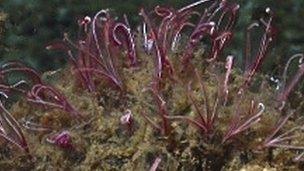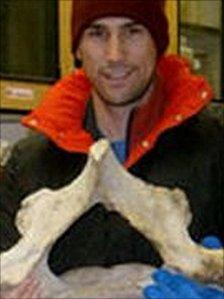Leeds student and the deep-sea 'zombie worms'
- Published

Osedax frankpressi - one of the variants of 'zombie worms' being studied
A University of Leeds PhD student is heading to California to study what have been termed "zombie worms".
Nick Higgs is jetting off to study the mysterious Osedax worms which eat bones and mainly live off the skeletons of whales deep on the ocean floor.
They are just one of a range of creatures that make their home around the carcasses of the giant mammals, in communities known as "whale falls".
Mr Higgs will join the research trip led by senior scientist Robert Vrijenhoek of the Monterey Bay Aquarium Research Institute.
He will take part in a week-long cruise in which they will survey four whale falls - three artificial and one natural.
By studying the worms, scientists hope to learn more about these communities evolved.

Osedax rubiplumus
Whale falls occur when a whale dies in the deep ocean and sinks to the sea floor. Unlike whales that die in shallow waters (less than 200m deep), whose carcasses are quickly devoured by scavengers, the whale carcasses in the deep oceans can provide a feast for a complex community of organisms.
Species found around whale falls range from clams and shrimp to larger creatures like octopuses, lobsters and even sharks.
Osedax worms were not discovered until 2002 when they were observed living on the bones of a decaying grey whale in Monterey Bay, California.
The worms, named after the Latin osedax or "bone-eating", are commonly called bone worms or zombie worms because of their strange feeding practices.
Even though the worms have no mouth or stomach, they are able to burrow into the solid bone to feed and can eventually destroy an entire whale skeleton, leaving virtually no trace of the fossil record.

Nick Higgs hopes to find evidence of worms in the fossil record
Nick is particularly interested in how they bore into the bone: "Because Osedax worms were only discovered a few years ago, there's still an awful lot we don't know about them.
"For example, different species of worm appear to like different parts of the bone, with some staying around the surface and others burrowing deep into the middle.
"I can also use CT scans to generate a 3D image of the bore holes and what they look like from the inside. Armed with this information, I hope to explore fossilized whale bones to see if I can find traces of this bone-eating worm in the fossil record."
Researchers rarely stumble across natural whale falls so a lot of the communities they study are from whales that have died through beaching, which they then take back out to sea and artificially 'sink'.
They will use submersible robots fitted with cameras to observe the communities surrounding the whales and may collect samples to study back in the lab.